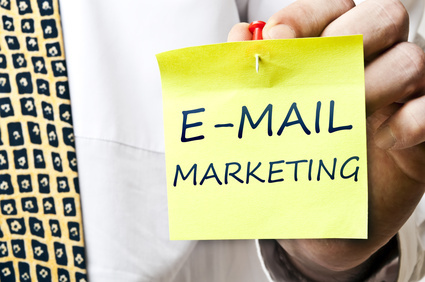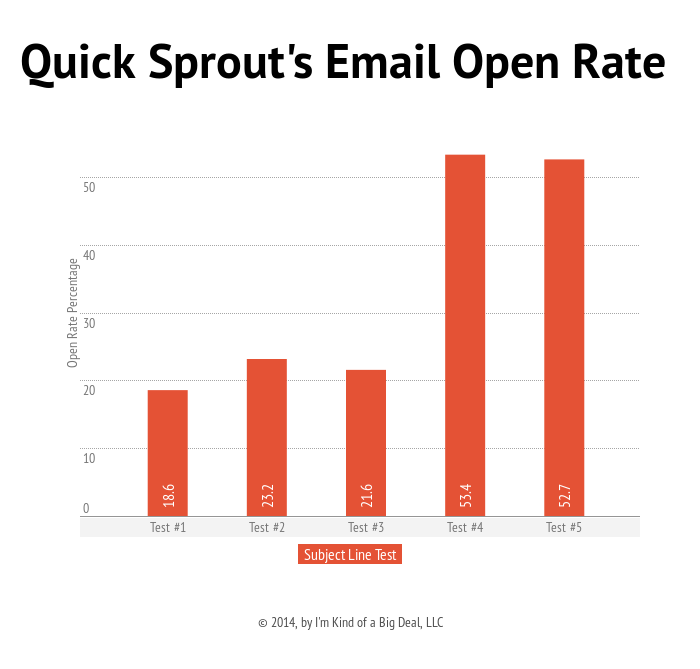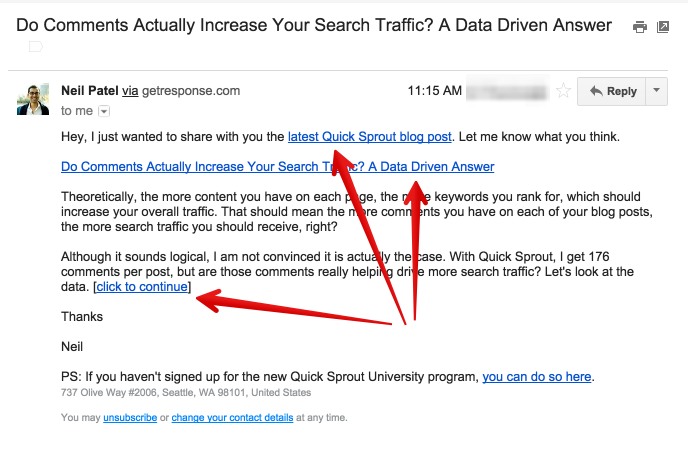6 A / B tests that you can conduct today (and get results)

Email marketing is one of the main secrets of business success for a significant number of entrepreneurs. But there is one nuance in it. It simply does not work automatically, even if you are an exceptional person. Instead, you have to do some serious work: create a list of addresses and emails that need to be constantly improved and subjected to testing. In this article, we will share with you the most effective A / B tests for email marketing that you find.
Testing is a major component in email marketing that is often overlooked. The real way to achieve great results here is to verify that it is in your letters that has the most tangible impact.
When you start testing your emails, you will gradually begin to discover things that you even had no idea whether they are working or not.
This alone gives you new perspectives, but more - more. Testing emails leads you to more successful email marketing, which in turn leads to overall success.
')
How do you test your emails?
First, answer the simple question: “How do you do your A / B testing?”
It is easy. Most email marketing programs have built-in split-testing functionality. All you need to do is activate it (sometimes you have to buy it separately), install your tests and wait for the results.
Here are some basic email marketing programs that use embedded A / B testing:
• Infusionsoft, ConstantContact, HubSpot Email
• AWeber, Marketo, Mailchimp.
This article is not a guide to using each of these programs. This is a guide on how to conduct in-built A / B testing on any of the email marketing platforms.
Slight warning
As you begin testing your emails, you may begin to feel that split testing is the solution to all your email marketing problems. Well, it is not. However, this is the best that you have.
There is one problem regarding email marketing that I would like to draw your attention to - statistical significance. The problem is not in the testing itself, but rather in how some programs produce results.
And, although you can do A / B testing in most email marketing programs, not all of them provide accurate results.
As Peter Borden explained in his article on Sumall:
I have not yet seen such an email program that really takes results and tries to determine if the latter are statistically significant. Most of them do not. The program simply looks at which version was opened, and which one reacted most of all - she won.
However, nothing prevents you from looking at the data with your own eyes, not trusting the “winner”. This is a pretty easy way to figure everything out.
To determine the value, use a special calculator. For example, this one. Just enter the data and analyze the results.

This calculator will allow you to personally work with the data and determine the significance / reliability of your A / B tests.
And now let's take a look at the tests that you can start using today, getting results that will change your business.
Timing: which day of the week or what time of the day is the highest open rate?
Timing in email marketing is just the question everyone is asking. What time of day or day of the week is the best for sending emails?
Everyone wants to know this, but only a few really try to figure it out in practice. Save yourself time, save yourself from suffering, and take a short break.
You see, there is no right answer to the question: "What time is the best?" Like everything else in marketing (and in life), the answer depends on a variety of circumstances.
Everything has an ideal time - tweets, posts, retweets, etc. It has a major impact on whether someone sees your emails, not to mention openness, clicking on links and conversion.
Finding the ideal time is not only the maximum percentage of discoverability, it is one of the main factors for obtaining the highest percentage of clickability and - conversion.
For example, you think that the letter you sent at 7:30 in the morning will get the best CTR. Perhaps this is so. Workers turn on their computers and begin to view their email. But there is one nuance. They hurry, open the letter, but perhaps they don’t have time to respond to it. Of course, you get high clickability, but your conversion ... it will be just awful.
But what if you send a letter at 4:30 in the afternoon, when most working people are bored, they are waiting for the end of the working day, they are looking for what can be distracted. They can see your letter, open it, and most likely become your customers. Open rate - less? Maybe. Higher conversion? Of course.
Do you see? It all depends on many things. Test, and, ultimately, you will find the perfect time.
Subject of the letter: Which topic of the letter increases the percentage of opening and conversion rates?
The most successful tests still include the work with the topics of letters. Here, look at the results that were obtained as a result of such testing:

Testing topics for letters can raise your open rate to heaven. It took a little effort, but in the end - a formula was found that increased this figure by 203%.
As part of email marketing, 203% can be easily interpreted as raising income by tens of thousands of dollars. Think about what is good in letters that no one opens? Statistically speaking, most people do not open messages that contain ads. The global opening rate is only 32%, and the click-through rate is a shocking 4%. Sorry, but such is life.
If you somehow forced people to open your letter, this automatically equates to success.
The subject of the letter is designed to increase your open rate. But that is not all. The subject of the letter not only makes people open the letter. It also shapes their perception of the entire message as a whole, whether they will perform the targeted actions indicated in it.
The result that is easiest to determine when testing a letter subject is the open rate. But you should also see what impact it has on the conversion percentage.
You can not afford not to test the subject of letters. They are the most important part of your entire message. But what exactly should you test? Here are 6 possible parameters to check:
1. Length: What works better - a long or short writing subject?
MailChimp website claims that 28-39 characters are the golden mean. True, practical testing shows that sometimes shorter versions work better.
2. Curiosity: What works better - the subject of the letter, which reveals its content, or one that causes curiosity?
Some marketers repeat, like some kind of mantra, that you should always reveal the content of the letter in its subject. Others - that curiosity is the only sure thing to increase the open rate. So what's better?
The topic of the Quicksprout letter reads: “Who is more active in social media? Men or women? "

Obviously, you will not recognize this until you have verified.
3. Marketing: What works better - the topic of the letter, which encourages people to make purchases, or one that carries value for the user?
It has been found that letter threads that carry some user value have a higher open rate. People look into their inbox and think: “What is there for me?” If your letter carries something good, they will most likely open it.

Notice that these e-mail names emphasize more the benefits they carry, and to a lesser extent the topic of purchase. Each of them contains some value.
4. Capital letters: What works better - the subject of a letter with words entirely composed of capital letters, or one that is written in lower case letters?
Most of us know that using capital letters can scare a significant number of readers, however, some marketers have used this technique quite successfully. Will it work with your emails?
5. Questions: What works better - the subject of the letter, which contains the question, or the one in which it does not exist?
Questions make users think. More precisely, the questions make them think about your letter. If the answer is not obvious, or if they want to know if their answer is correct, then your “piggy bank of clicks” will be replenished.
6. Greetings: What works better - the subject of the letter, in which the user is addressed by name, or the one in which they do not?
Appeals by name can be very powerful, or they can completely prevent the user from writing. This is a rather complicated problem, because some of the users may like personalization, while other people see this as sycophancy, artificiality, or even a violation of personal space.
The best way to find out is practice. After you find the “work” writing topics suitable for you, you will receive one of the most powerful trumps in the field of email marketing.
Sender: What works better - sending a letter on behalf of the company or on behalf of a person?
Almost every mail client shows the name of the sender before the user opens the letter.
In fact, the name of the sender is the first thing people notice before reading the topic of the letter! And all due to the fact that many mail clients display the name of the sender earlier than the subject of the letter.
Here's how Gmail displays letters in the inbox: 1) The name of the sender, 2) The subject of the letter, and behind it - its small preview.

From all this it follows that the sender of the message has a huge impact on the open rate of letters and other indicators related to it.
The best test will be this: send a letter on behalf of an ordinary person, and on behalf of the company. On an intuitive level, it is clear that people would rather open a message from the first, rather than rely on some faceless corporate entity.
But can you be so sure of that? Only if you check it yourself.
A greeting: What works better — a personalized or non-personalized greeting?
In all forms of marketing, personalization is perceived as a major breakthrough.
However, some evidence suggests that it may not be as effective. Have you encountered interference with your personal life? If so, then you realize that personalization may look a little scary.
Back in 2012, researchers concluded: personalized emails do not make any impression on buyers. The Sanil Watall report from the Temple University Fox School of Business states:
Given the increased interest in cybersecurity caused by phishing, identity theft and credit card fraud, many buyers will be suspicious of any letters, especially with a personalized greeting.
Now, as a result of large cyber scandals, buyers are probably even more careful. But are your customers so careful? This aspect has been tested more than once. Results vary greatly. Although, often, the differences may be quite insignificant.
Foolishadventure conducted a test: a personalized letter against a non-personalized letter. First post:

Open rate is slightly higher, at 1%. The clickability, in turn, is higher by 2%.

However, with subsequent testing, the opposite was true. Personalized greeting had a lower open rate or CTR.
The point here is not that "personalization is better" or "stereotyped is better." And the fact that Foolishadventure should hold a couple more tests.
Another key point is that it is you who should conduct testing to find out what the results will be.
Length: What works better - a complete email or where you want to follow the link?
To fully read most of the letters from Neil Patel, you need to click on the link in them. Why? All this is related to the purpose of his email marketing. In the case of Quicksprout, in the letter below, Neil will try to provide subscribers with the most comprehensive information on the Internet so that they can get a full impression of their blog: they chatted through comments and interacted at a higher level. That is why they are given three options for following links.

Other marketers use a longer approach. In particular, Ramit Seti from IWT writes really great emails, and his email marketing, in turn, is beyond praise.
Both approaches work. All testing depends on the purpose of your email marketing. Want to drive traffic, improve conversions, increase the number of readers? Decide on the goal of your marketing, or let the results of your testing show it to you.
Call to action: What works better - button or text?
Any good letter contains a call to action (CTA) - something that you ask the reader to do. It may be a simple “read the rest of the article,” or it may be more significant “register and get free trial access.”
Should you embed a call to action in a string of text? Or should you use a button? Or both?
The issue of CTA in an email is one of the most important. The biggest and most shocking mistake ever noted in email marketing was the complete lack of a call to action! Whatever you like, but embed CTA in your letter and then find out which way gives you a big conversion.
This test is especially valuable because it gives you the opportunity to take a closer look at the aspects that are most relevant in email marketing - conversion or clickability.
You can (and should) conduct more tests related to the results of your call to action. Once you figure out which one gives the highest conversion, you can start testing the color of the button, its size and other features. You should also try out the various options for a call to action, and even its various goals.
Test plan
So, you read this material, and now you think: “Eh, great. And then what? "
Let's briefly outline the things that should be done next. First, check with your email marketing provider for how to run and how to use A / B testing. Secondly, conduct the test - only one test. Once you get the results, proceed to the next test.
Below is a list of these tests in the sequence in which you must run them. They work like a pyramid, only the other way around: the first test allows you to capture the most open letters, from which more conversions follow in the final tests.
1. Timing: What day of the week or what time of the day is the open rate highest?
2. The subject of the letter: Which topic of the letter increases the percentage of openability and conversion?
3. Sender: What works better - sending a letter on behalf of the company or on behalf of a person?
4. Greeting: What works better - personalized or non-personalized greeting?
5. Length: What works better - a complete email or where you want to follow the link?
6. Call to action: What works better - button or text?
Once you have completed these six basic tests, proceed to more advanced options, or just start over from the beginning by re-running each of the tests.
And which A / B tests did you use? And what gave the real effect?
Source: https://habr.com/ru/post/242537/
All Articles